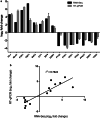Transcriptomic and proteomic profiling revealed reprogramming of carbon metabolism in acetate-grown human pathogen Candida glabrata
- PMID: 33388061
- PMCID: PMC7778802
- DOI: 10.1186/s12929-020-00700-8
Transcriptomic and proteomic profiling revealed reprogramming of carbon metabolism in acetate-grown human pathogen Candida glabrata
Abstract
Background: Emergence of Candida glabrata, which causes potential life-threatening invasive candidiasis, has been widely associated with high morbidity and mortality. In order to cause disease in vivo, a robust and highly efficient metabolic adaptation is crucial for the survival of this fungal pathogen in human host. In fact, reprogramming of the carbon metabolism is believed to be indispensable for phagocytosed C. glabrata within glucose deprivation condition during infection.
Methods: In this study, the metabolic responses of C. glabrata under acetate growth condition was explored using high-throughput transcriptomic and proteomic approaches.
Results: Collectively, a total of 1482 transcripts (26.96%) and 242 proteins (24.69%) were significantly up- or down-regulated. Both transcriptome and proteome data revealed that the regulation of alternative carbon metabolism in C. glabrata resembled other fungal pathogens such as Candida albicans and Cryptococcus neoformans, with up-regulation of many proteins and transcripts from the glyoxylate cycle and gluconeogenesis, namely isocitrate lyase (ICL1), malate synthase (MLS1), phosphoenolpyruvate carboxykinase (PCK1) and fructose 1,6-biphosphatase (FBP1). In the absence of glucose, C. glabrata shifted its metabolism from glucose catabolism to anabolism of glucose intermediates from the available carbon source. This observation essentially suggests that the glyoxylate cycle and gluconeogenesis are potentially critical for the survival of phagocytosed C. glabrata within the glucose-deficient macrophages.
Conclusion: Here, we presented the first global metabolic responses of C. glabrata to alternative carbon source using transcriptomic and proteomic approaches. These findings implicated that reprogramming of the alternative carbon metabolism during glucose deprivation could enhance the survival and persistence of C. glabrata within the host.
Keywords: Acetate; Candida; Candida glabrata; Carbon metabolism; Liquid chromatography tandem-mass spectrometry; Proteomic; RNA-sequencing; Transcriptomic.
Conflict of interest statement
The authors declare that they have no competing interests.
Figures






Similar articles
-
The glyoxylate cycle and alternative carbon metabolism as metabolic adaptation strategies of Candida glabrata: perspectives from Candida albicans and Saccharomyces cerevisiae.J Biomed Sci. 2019 Jul 13;26(1):52. doi: 10.1186/s12929-019-0546-5. J Biomed Sci. 2019. PMID: 31301737 Free PMC article. Review.
-
Glyoxylate cycle gene ICL1 is essential for the metabolic flexibility and virulence of Candida glabrata.Sci Rep. 2019 Feb 26;9(1):2843. doi: 10.1038/s41598-019-39117-1. Sci Rep. 2019. PMID: 30808979 Free PMC article.
-
The evolutionary rewiring of ubiquitination targets has reprogrammed the regulation of carbon assimilation in the pathogenic yeast Candida albicans.mBio. 2012 Dec 11;3(6):e00495-12. doi: 10.1128/mBio.00495-12. mBio. 2012. PMID: 23232717 Free PMC article.
-
Proteomic analysis of the pH response in the fungal pathogen Candida glabrata.Proteomics. 2008 Feb;8(3):534-44. doi: 10.1002/pmic.200700845. Proteomics. 2008. PMID: 18186024
-
The oxidative stress response of the opportunistic fungal pathogen Candida glabrata.Rev Iberoam Micol. 2014 Jan-Mar;31(1):67-71. doi: 10.1016/j.riam.2013.09.012. Epub 2013 Nov 19. Rev Iberoam Micol. 2014. PMID: 24270068 Review.
Cited by
-
Developmental deficits, synapse and dendritic abnormalities in a Clcn4 KO autism mice model: endophenotypic target for ASD.Transl Psychiatry. 2025 Jan 25;15(1):28. doi: 10.1038/s41398-024-03201-6. Transl Psychiatry. 2025. PMID: 39863599 Free PMC article.
-
Proteomic characterization of clinical Candida glabrata isolates with varying degrees of virulence and resistance to fluconazole.PLoS One. 2025 Mar 25;20(3):e0320484. doi: 10.1371/journal.pone.0320484. eCollection 2025. PLoS One. 2025. PMID: 40131896 Free PMC article.
-
Integrative transcriptome and proteome revealed high-yielding mechanisms of epsilon-poly-L-lysine by Streptomyces albulus.Front Microbiol. 2023 Apr 20;14:1123050. doi: 10.3389/fmicb.2023.1123050. eCollection 2023. Front Microbiol. 2023. PMID: 37152744 Free PMC article.
-
Exploring the effects of culture conditions on Yapsin (YPS) gene expression in Nakaseomyces glabratus.Open Life Sci. 2024 Nov 26;19(1):20220995. doi: 10.1515/biol-2022-0995. eCollection 2024. Open Life Sci. 2024. PMID: 39655190 Free PMC article.
-
Real-world usage and effectiveness of recombinant factor IX Fc in haemophilia B from the B-SURE study in France.Ther Adv Hematol. 2025 Jan 26;16:20406207241311535. doi: 10.1177/20406207241311535. eCollection 2025. Ther Adv Hematol. 2025. PMID: 39872008 Free PMC article.
References
-
- Pfaller MA, Andes DR, Diekema DJ, Horn DL, Reboli AC, Rotstein C, et al. Epidemiology and outcomes of invasive candidiasis due to non-albicans species of Candida in 2496 patients: data from the Prospective Antifungal Therapy (PATH) registry 2004–2008. PLoS ONE. 2014;9:e101510. doi: 10.1371/journal.pone.0101510. - DOI - PMC - PubMed
MeSH terms
Substances
Grants and funding
LinkOut - more resources
Full Text Sources
Other Literature Sources
Miscellaneous

